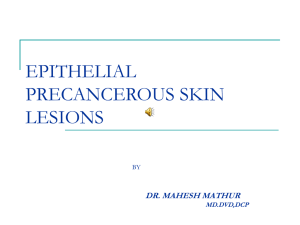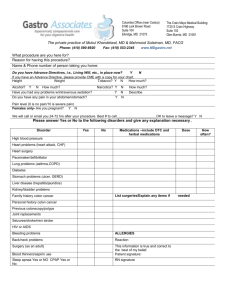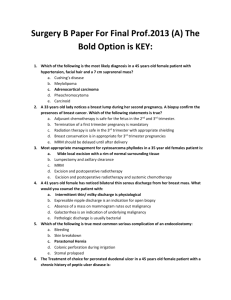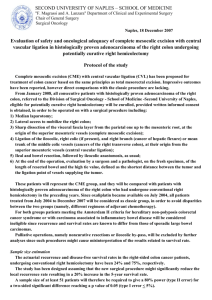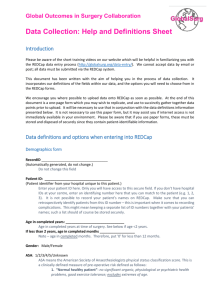SAMPLE EXAM I
advertisement
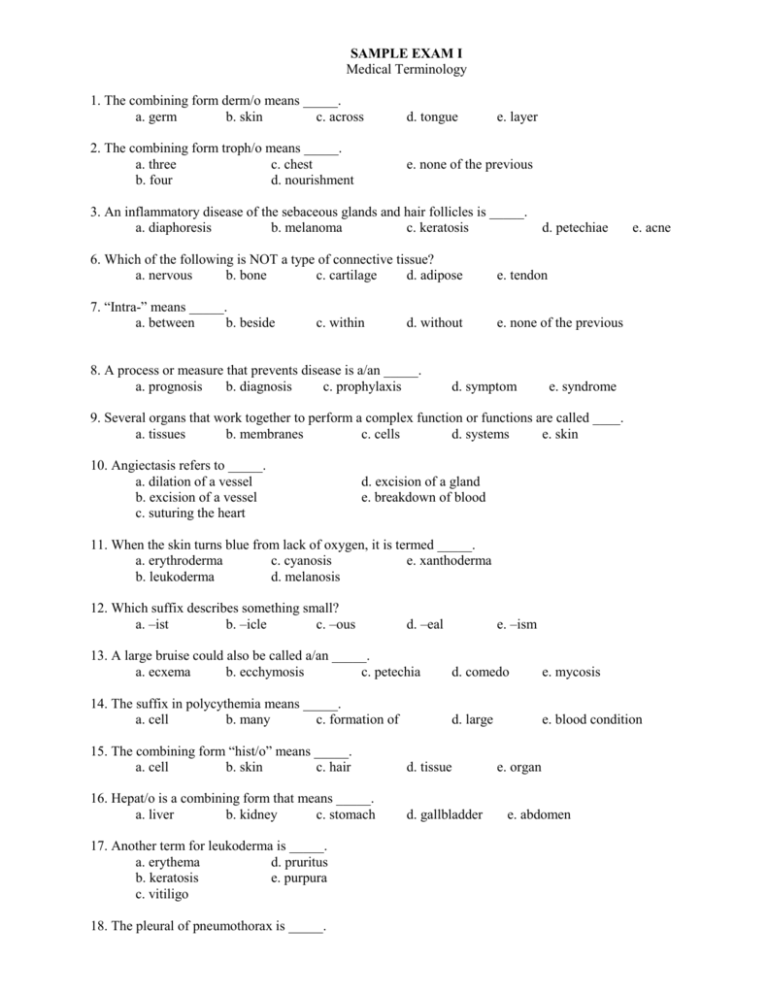
SAMPLE EXAM I Medical Terminology 1. The combining form derm/o means _____. a. germ b. skin c. across 2. The combining form troph/o means _____. a. three c. chest b. four d. nourishment d. tongue e. layer e. none of the previous 3. An inflammatory disease of the sebaceous glands and hair follicles is _____. a. diaphoresis b. melanoma c. keratosis d. petechiae 6. Which of the following is NOT a type of connective tissue? a. nervous b. bone c. cartilage d. adipose e. tendon 7. “Intra-” means _____. a. between b. beside e. none of the previous c. within d. without 8. A process or measure that prevents disease is a/an _____. a. prognosis b. diagnosis c. prophylaxis d. symptom e. acne e. syndrome 9. Several organs that work together to perform a complex function or functions are called ____. a. tissues b. membranes c. cells d. systems e. skin 10. Angiectasis refers to _____. a. dilation of a vessel b. excision of a vessel c. suturing the heart d. excision of a gland e. breakdown of blood 11. When the skin turns blue from lack of oxygen, it is termed _____. a. erythroderma c. cyanosis e. xanthoderma b. leukoderma d. melanosis 12. Which suffix describes something small? a. –ist b. –icle c. –ous d. –eal e. –ism 13. A large bruise could also be called a/an _____. a. ecxema b. ecchymosis c. petechia d. comedo e. mycosis 14. The suffix in polycythemia means _____. a. cell b. many c. formation of d. large e. blood condition 15. The combining form “hist/o” means _____. a. cell b. skin c. hair d. tissue 16. Hepat/o is a combining form that means _____. a. liver b. kidney c. stomach d. gallbladder 17. Another term for leukoderma is _____. a. erythema d. pruritus b. keratosis e. purpura c. vitiligo 18. The pleural of pneumothorax is _____. e. organ e. abdomen 2 a. pneumothoraxes b. pneumothoraces c. pneumothoraxies d. pneumothoricies 19. Colostomy describes a/an _____. a. creation of an opening in the colon b. incision in the colon c. excision of the colon d. binding of the colon e. withdrawal of fluid from the colon 20. Excessive coloration of the skin is called _____. a. hyperpigmentation c. dermabrasion b. keratosis d. dermatitis e. urticaria 21. A/An _____ condition is one that develops slowly and persists over time. a. benign c. chronic e. idiopathic b. malignant d. acute 22. A patient exhibiting hyperhidrosis would appear to be _____. a. leaning to the left c. sweating excessively e. flushed b. leaning forward d. pale 23. Another term for dry skin is _____. a. scleroderma c. xeroderma b. erythroderma d. xanthoderma e. keratosis 24. An infection around a nail is called _____. a. dermatofibroma c. keratosis b. paronychia d. seborrhea e. urticaria 25. QOD is a banned abbreviation meaning _____. a. every day b. every other day c. complains of 26. Infestation with lice is _____. a. alopecia b. dermatitis c. pediculosis d. onychophagia d. four times a day e. immediately e. necrosis 27. Microscopic examination of tissue removed by a syringe, knife or needle is most accurately termed a _____. a. frozen section c. curettage e. patch test b. cryosurgery d. biopsy 28. Destruction of tissue by drying it with high-frequency electric current using direct skin contact is _____. a. laser therapy c. electrocautery e. debridement b. fulguration d. electrodesiccation 29. Removal of foreign material and dead/damaged tissue from a wound is _____. a. necrosis c. debridement e. dermatoplasty b. lipectomy d. rhytidectomy 3 SAMPLE WRITTEN PORTION al dermato lip melan oma ous rrhea cutane ectomy logy myc onycho plasty sebo derm intra malacia necr osis tricho sub Pertaining to under the skin Pertaining to within the skin Abnormal condition of death Nail softening Oil discharge Excision of fat Black tumor Study of skin Abnormal condition of hair fungus 3. Correctly spell any incorrectly spelled words in this list. antipuretic curettage hidropoiesis sudoriferous 4. Identify the following abbreviations. NPO p.c. BCC I&D 5. Build terms for the following expressions. a. study of the stomach and intestines b. bursting forth of blood 6. Break each term into its component parts, define each part, then define the entire term. a. lipocytes b. dysplasia c. gastroenterology d. endocrine e. microlithiasis

